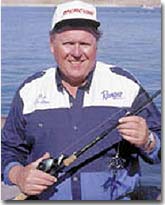Shifting Gears For Low Water
Shifting Gears For Low Water
By Dub LaShot  I am fortunate to live close to one of the best places in the Pacific Northwest to fish for big summer smallmouth bass. The mighty Columbia River is a wonderful smallmouth fishery, but this year, it will most likely provide some unusual challenges for smallmouth anglers. Each year brings new challenges for those who seek the bronzebacks of the Columbia. I am fortunate to live close to one of the best places in the Pacific Northwest to fish for big summer smallmouth bass. The mighty Columbia River is a wonderful smallmouth fishery, but this year, it will most likely provide some unusual challenges for smallmouth anglers. Each year brings new challenges for those who seek the bronzebacks of the Columbia. As most of you know by now, the Pacific Northwest is experiencing a prolonged drought. River flows are down as much as 50 percent in some areas. The Columbia has been affected as well, with flows 30 to 40 percent below normal. I believe this drop in flow will make the river fish differently than other years. Although a challenge, the big river should still produce some quality fish if anglers make the proper adjustments to the new levels. The two big differences we will see this year are reduced current and super-clear water. Both situations will contribute to very tough fishing conditions. The current normally helps position smallmouth bass and makes them easier to find. I believe we will have shorter windows to take advantage of the current, as peek power periods will dictate the release of water and the current needed to position smallmouths. The short duration of current will likely cause some major feeding activity and timing will play a big key in success. We also will have super-clear water brought on by the lack of rain. This should make the smallmouths in the Columbia very sensitive to all lures and more difficult to catch. The smallmouth will most likely be more sensitive to fishing pressure, and respond by moving into deeper water. Conditions that make the bass less wary will be keys to success. Low-light times will be important and you will need to be in a productive area at first light to take advantage of that first hour. The same should be true with the last hour of daylight. Your success on any given outing could come in this short window if current is not present the rest of the day. The smallmouths will move into deeper water than in past years and we will have to adapt our presentations to be successful. I generally don't fish that deep in normal-flow years when the water has some color and 20 feet would be considered deep. This year, 25 to 30 feet or deeper is very possible if you don't have any low-light conditions to bring the fish up. Wind will definitely help and we certainly have enough windy days on the Columbia to bring the fish up. At times anglers will try to avoid the wind and look for more sheltered water. That may be a mistake this year and those who brave the winds will likely have more success than those who run for cover. Summer showers are rare on the Columbia, but I would make sure I was on the water if a shower did come along. Techniques used in normal water years will not change a great deal. I believe the windows for lures like crankbaits and spinnerbaits will be shorter, and mostly limited to low-light periods. Strong current periods, if and when they occur, will lengthen the productive times for reaction lures. So, what do we do the 90 percent of the day when ideal conditions are not present? Hot days and slick water conditions are when I'll go deep, very deep. I believe light Carolina rigs and split shot rigs will rule the day under tough conditions. Small plastic baits fished on these rigs will be good choices. This may be the year that a dropshotting technique is a key to catching these deep smallmouths and that is something I plan to experiment with. The same drop-offs that normally hold the bass will most likely still hold them, only they will be deeper than past years. Deep-water dragging is a technique that has been catching on for Columbia smallmouths in recent years and will be a good choice this year. The technique involves drifting with the current down a good drop-off controlling your depth with the trolling motor. Also , if you drift too fast, the intermittent use of your trolling motor will slow the boat down and help you stay in contact with the bottom. Deep-water dragging might call for heavier weights than normal to help keep the lure close to the bottom. Many anglers use a "slinky" for a weight. and the method was actually adopted from the steelhead anglers. A slinky is a nylon tube that you put round lead weights in and attach it to a swivel instead of a traditional weight on your line. It is very snag resistant and slides over the bottom better than other methods. It is a very effective method to fish long drop-offs and cover large areas in search of fish. Don't give up on the Columbia though. It should provide some excellent fishing for the anglers who can adapt to the drought conditions we face. See you on the river. What is the key to unlock the mystique of the newest West Coast bass fishing techniques? Bass West Magazine! Read about the newest trends and baits winning high dollar tournaments developed specifically for the West Coast before they become mainstream. This article is courtesy of Bass West Magazine.
Bass West Magazine
|
